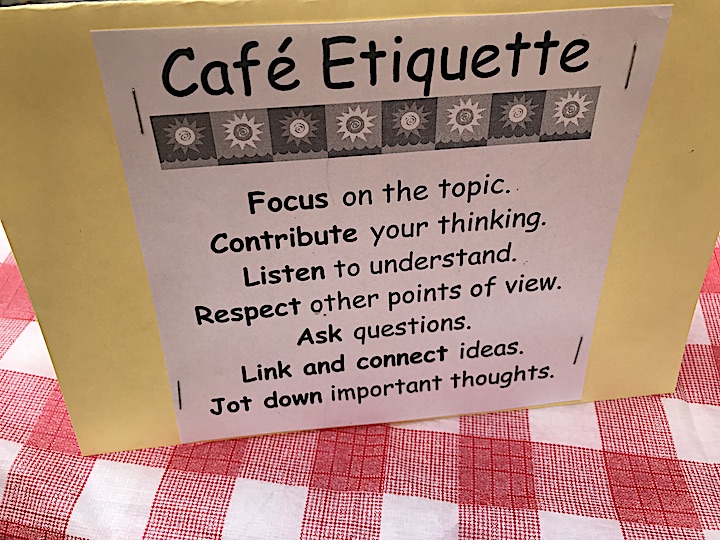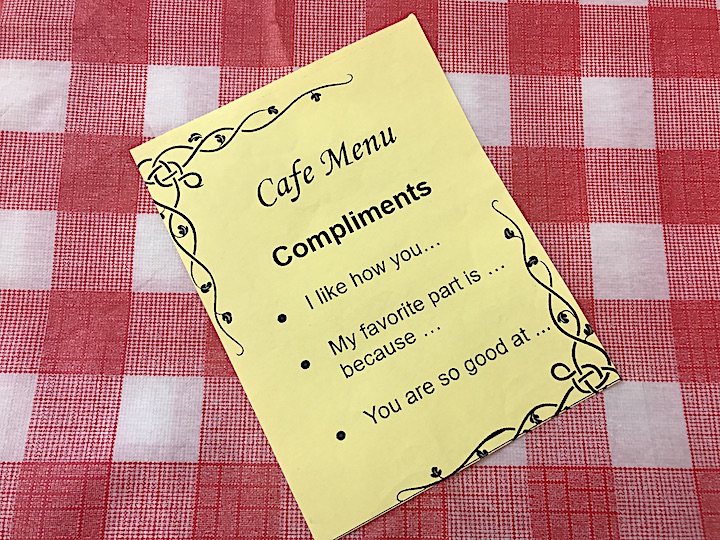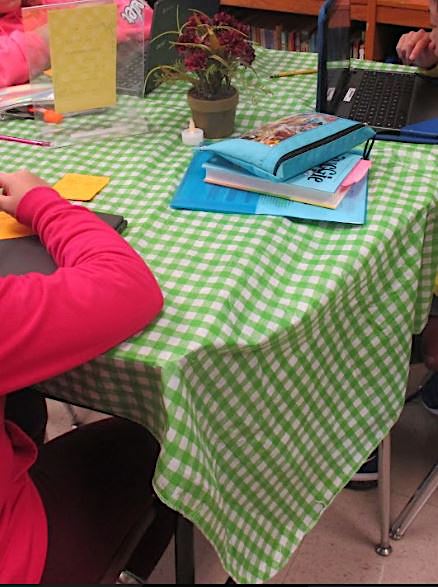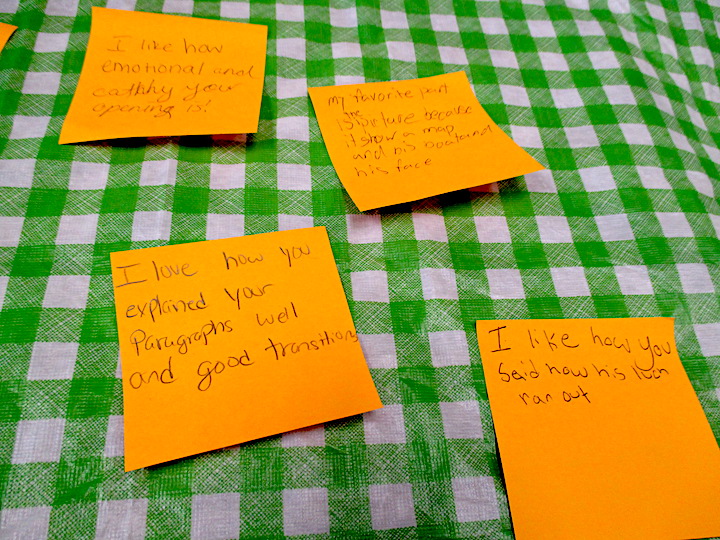Try Café Conversations for Deeper Learning
By Kelly Owens

What are Café Conversations?
These are structured discussions you host in your classroom, conference, or community. This conversation format invites participants to share ideas and listen to different perspectives. Food isn’t served up in these cafés … just food for thought! Students want to talk – and need to talk – in your classroom. Be an architect of productive classroom conversations!
This teaching strategy works for any subject area at any grade level. Host a conversation when introducing topics, assessing, sharing student projects, facilitating social emotional learning, and problem solving.
Discussions enhance what you are already teaching. Student engagement skyrockets when learners deepen their understanding and gain appreciation for diverse perspectives. It’s the kind of talk teachers DO want to hear in the classroom – on-task, productive, and reflective.
Why a Café Vibe?
Cafés are social places for people to come together for discussion and entertainment. How many times have you said, “Let’s meet for coffee”? The informality of the setting offers a place to exchange ideas, discuss philosophies, share art, and even seal deals. Think back to cafés you have visited. Was there a comfortable, relaxed mood that invited people to be open to sharing?
Students crave similar interactions and connections in our classrooms. Good conversation skills must be modeled and taught. This instructional strategy teaches students simple protocols and core principles for good discussion.
Why Do We Need Classroom Conversations?
It is important to balance the time spent communicating on digital devices with in-person conversations. Digital communication has its own set of conversation conventions. Before Zoom activities and Google Meets, students need to be taught norms and protocols for respectful discourse.
Likewise, in-person discussions require their own procedures to use time most productively, achieve learning goals, and allow different perspectives to be represented. Help students build a toolbox of conversation skills they can access in their personal and future professional lives.
Considerations for Structuring Conversations
You may remember having a talking stick when you were a primary grade student. It trained speakers and listeners about turn-taking in discussions. Similarly, this strategy teaches students how to actively respond, listen, and reflect during the process.
Rules for Etiquette
When hosting these discussions in my classes, regardless of the grade, subject, or time available, the same etiquette rules usually apply each time.

Provide Sentence Stems
Students must be taught what productive talk looks like. Susan O’Brien, an educator with about 40 years’ experience, said providing sentence stems and facilitating time to think are helpful parts of the discussion routine. Additionally, O’Brien encourages back-and-forth discussion with clarification questions and deep-thinking questions about evidence-based claims.
Her suggested sentence stems vary depending on their purpose. For example, if a student wants to respectfully challenge, they might say, “Does it always work that way?” Or if a student needs to clarify their understanding, they could ask, “Are you saying ___?”

Create a Café Vibe
Students love the excitement and intrigue of entering the classroom on conversation days. Adding cafe ́ accents to the room makes it look and feel different. Changing up the norm goes a long way to motivate and interest students.
To give your classroom a cafe ́ look, you may include some of the following decorating options:
✻ large butcher block paper to cover tables or desk clusters (*more about the usefulness of these tablecloths in the note taking tips below)
✻ cafe-style instrumental music
✻ outdoor cafe ́seating image projected on the board
✻ tent cards with etiquette rules for each table or desk cluster
Keep these supplies in a large box or bin in your classroom. You can easily pull them out for quick conversations and return them to the box for storage just as easily.
Places to Jot Ideas
It is important to have places for students to take notes before, during, and after conversations. In addition to any projects or notes they may bring to share with the group, you can supply other note taking materials such as:
✻ sticky notes for writing compliments or questions for a groupmate
✻ paper tablecloths and crayons or markers so students can write on their tabletop coverings (It’s really the same idea as sticky notes, but it’s much more fun!)
At the conclusion of the activity, it is helpful to debrief as a class and highlight notable comments discussed in different groups. This is when the teacher can borrow select sticky notes to display on a class chart or display select tablecloths. By making students’ thinking visible, the ideas can be revisited well after the activity.
Use this Strategy across Your Curriculum
Find the format that works best for you and your learning objectives. The nonprofit website conversationcafe.org has tips, materials and resources readily available for you to start the DIY dialogue process in classrooms or community settings. Alternatively, you can design materials and formats adapted to your learners and their needs. Sample cross-curricular activities include:
Literacy-focused Café
Interactive forums deepen students’ thinking when sharing book responses, author studies, literary analyses, and students’ own writing. Conversations can focus on discovering commonalities between book themes or characters.
Science-focused Café
Student scientists can meet to discuss current events, compare experiment results, analyze data, and present inventions. Through conversation, students can discuss patterns they discover, make connections, and ask and answer questions.
Social Studies-focused Café
Matthew Lynch’s article in The Edvocate explains how students can assume their biography projects’ personalities when gathering for a post-research project conversation. Reflection questions can focus on what students thought their character learned after hearing the different perspectives.
Opening Days Café
During the first days of school, teachers often have students design a poster or project about themselves as a get-to-know you activity. One interactive and inclusive way for students to learn about their new classmates is to share their finished projects using the Café Conversation strategy. The compliments sentence stems shown earlier can help you create a positive classroom environment beginning on Day 1!
Start the Conversation at the Start of the School Year
Once you’ve decided on your etiquette rules, sentence stems, decorations, and protocols that work for you and your students, stick with them each time. Build on the routine you establish as early as the opening days of school, each time adding more sophisticated elements. Keep everything in a box or bin, so decorations are easily accessible for impromptu discussions.
For days when conversations may last the whole class time, consider the opportunity for each student to bring in their own individual snack or drink to your classroom cafe ́ (if your school permits). Anything that changes up the ordinary and gets your students actively engaged is going to motivate and excite learners.
Café Conversations can bring out extraordinary discussions in your student-centered classroom. Reserve a time in your planbook today!
References
Lynch, M. “How to Implement the Café Conversations Teaching Strategy in Your Classroom.” The Edvocate, April 2022, https://www.theedadvocate.org/how-to-implement-the-cafe-conversations-teaching-strategy-in-your-classroom/.
O’Brien, S. “What Productive Talk Looks Like in the Elementary Grades.” Edutopia, October 2019, https://www.edutopia.org/article/what-productive-talk-looks-elementary-grades.
Kelly Owens is a literacy teacher who helps sixth grade readers and writers overcome past literacy struggles by building stamina, confidence, and a greater love of learning. As a teacher with over 28 years of experience, she has proudly represented Hillsborough Township Public Schools as a NJ Governor’s Teacher of the Year. She also co-created Buddies for the Birds, which was featured on Emmy Award-winning Classroom Close-up NJ. Kelly earned her Ed.M. from Rutgers University. Additional writing credits include published work with The King School Series (Townsend Press), The Mailbox magazine, and MiddleWeb.



































